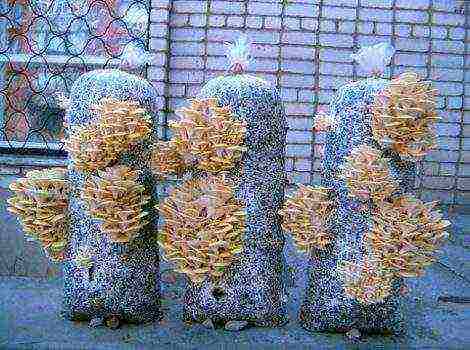Content
- 1 Before you start growing mushrooms
- 2 Premises
- 3 Substrate
- 4 Mycelium
- 5 Champignon plantation care
- 6 Conditions for growing champignon mushrooms
- 7 Preparing compost for growing mushrooms
- 8 What should be the mushroom mycelium
- 9 Technology for growing mushrooms in the basement (in bags)
- 10 Technology for growing mushrooms in the country (in a greenhouse, in a garden)
- 11 Growing champignons at home (on the balcony)
- 12 Growing methods
- 13 Substrate preparation
- 14 Landing on a regular horizontal ridge
- 15 Growing mushrooms at home on shelves
- 16 How to grow champignons in a basement in regular bags
- 17 Container way
- 18 How to grow champignon mushrooms in blocks and what is it
Growing mushrooms in a private household, in dachas and even in apartments is becoming fashionable today. Firstly, in the store, mushroom products are not sold at a low price. Secondly, the homemade mushroom, grown without the use of unknown chemicals, is environmentally friendly and safe for consumption. Thirdly, mushroom growing can be made a profitable business, or at least a good source of additional income. Fourthly, it is a very interesting and exciting hobby. Take a substrate, put mycelium in it, create conditions. And it starts to grow like mushrooms.
Growing champignons at home for beginners
Before you start growing mushrooms
You need to think well and weigh your desire and capabilities on two scales. If they are at about the same level, it is worth the risk. Information for beginners: growing mushrooms at home is a more laborious process than growing oyster mushrooms. But less long-term and more effective than growing porcini mushrooms.
It will take certain costs for the purchase of materials, arrangement of the premises, as well as patience and certain skills. Provided that you already have a suitable room and you only need to create favorable conditions in it.
Premises
It should be moderately cool, such as a cellar or basement. If neither one nor the other is not present, it is difficult to advise anything. Perhaps a garage or greenhouse will do (during the cold season). In spring and early summer, before the onset of extreme heat, mushrooms can be grown without a room at all. The main thing is that the air temperature is not higher than + 20 ° С. Indoors, in the case of year-round cultivation, the temperature should be constantly maintained in the range of + 12 ° С ... 18 ° С, and the humidity should be in the range of 65-85%.
Premises for growing mushrooms
Substrate
The most important item on the list of prerequisites for the successful cultivation of mushrooms is the substrate (or, as it is also called for its composition, compost). The following composition is generally recognized as a fruitful compost option.
- Horse or cow dung (or pork or bird droppings, which can be taken, but not desirable).
- Straw.
- Urea.
- Superphosphate.
- Gypsum.
- A piece of chalk.
- Alabaster flour.
Substrate for growing mushrooms
Table. The proportions of the components for making compost from mullein or horse manure.
Table. The proportions of the components for the composting of poultry manure.
By the way! To cover a one square meter area with mushroom compost, you need compost made from 40 kg of straw base (the rest of the components, according to proportions).
Video - How to disinfect mushroom substrate
How to prepare compost
It is better to carry out this procedure in the air or, in extreme cases, in a regularly ventilated area. As the compost matures in a heap, where the straw is layered with manure and watered with water, the heat can rise to + 70˚C. There is an intensive release of carbon dioxide, water and ammonia vapors into the atmosphere. Of course, a person should not breathe this mixture for a long time.
It is good to place the compost place in the sun (the higher the temperature inside this “puff cake”, the faster and better the compost will ripen). But it is worth providing shelter from rains, since heavy rain can wash out all the useful components necessary for the growth of future mushrooms from the compost.
Compost pit for preparing the substrate
Advice! If it is not possible to protect the compost heap with a canopy from atmospheric precipitation, cover it with roofing material or a thick film before the rain. Be sure to lift the film from the sides, leaving the sides open.
The straw for the substrate must be fresh, dry, free from mold and other defects. Before starting laying, the straw is soaked in a large tank of water for a day. If there is no such reservoir, spread the straw on polyethylene and water it abundantly several times a day, preventing it from drying out.
Laying the compost heap
Straw and manure prepared in this way begin to be laid in layers.
The first layer is straw. Then - manure or droppings.
Each layer of straw is sprinkled with ammonium nitrate, urea in the proportions indicated in the table.
Each layer of straw is watered abundantly with water.
In total, there should be at least 3-4 layers of straw and, accordingly, the same amount of manure.
You need to finish the laying with straw.
Water once again to keep the moisture content of the compost heap constant.
The heap must be at least one meter high. The length and width are arbitrary.
Preparing compost for cultivation
champignons
For a week, the multi-layered structure is basking in the sun. Then comes the moment of the first shaking up. The procedure is carried out with a pitchfork. Shaking up a compost heap is not easy. But they cannot be neglected, since for the speedy composting inside it is necessary to provide oxygen access.
During the first shaking, plaster of Paris is added. It will improve the structure of the compost.
The second shaking is carried out without waiting for the next week, 3-4 days after the first. This time superphosphate and chalk are added.
Important! If the pile is slightly dry in the sun, it is watered abundantly with water. It is impossible to dry out the compost, its formation will stop.
The third and fourth shaking is carried out in four consecutive days. After three weeks, the compost heap will lose its strong ammonia smell and will turn into a pleasant chocolate color. The straw in the compost will become soft and tear with your fingers.
Ready-made compost for growing mushrooms
High-quality compost substrate, completely ready to use, does not stick to the palm, bounces in the fist when squeezed, leaves a wet, but not dirty mark on the skin.
Advice! If you overmoisten the pile, and moisture literally flows out of the compost during compression, it should be decomposed to dry (but not dry, but only reduce the humidity to 60%), adding half the rate of chalk.
The finished substrate is filled with racks, boxes or other containers where mushrooms will be grown. The temperature of the substrate must be lowered before the introduction of the mycelium.
Germination composting process
Preparation of the substrate for further planting of the mycelium
If you plan to grow mushrooms in a room specially designated for this enterprise, for example, on the earthen floor of the cellar, the compost is poured directly onto the floor, in a layer of 70 cm, forming beds with an area of ½ m² or 75x75 cm.
- If in the basement you have equipped racks on which future mushroom crops will grow neatly, they must be equipped with bumpers, and then you can put the compost directly on the racks, with a layer of 45 cm.
- If cultivation is supposed to be in boxes that can be stacked in the same basement or cellar (no more than two meters stack height), because the mushrooms do not need light for development, the compost is poured into boxes. Backfill layer - 25 centimeters
- If you grow mushrooms in an open or greenhouse ground, the compost is rammed directly onto the surface of the ground, 25-30 cm high. The beginning of the laying is early spring, when the ground thaws. Sheds are made over the open ridge to protect from precipitation and sunlight that is too intense for shade-loving champignons.
- The compost is well compacted by hand, the surface is carefully leveled.
Racks for champignons
Mycelium
After the preparatory work, the most important moment comes - planting the mycelium. Mushroom mycelium can be planted at a soil temperature of no higher than + 28 ° C at a depth of 5 cm.Check the temperature with a thermometer. This is important because exceeding even two degrees will kill the mycelium.
The planting material for growing champignons, like other cultivated mushrooms, is a sterile mycelium, which is grown in special laboratories. Champignons for cultivation in culture are selected in two varieties:
- double-sided white;
- double-cornered brown.
Champignon mycelium
There are no significant differences in their taste and nutritional value. The only difference is in the color of the mushroom, according to the name, white or brown. Sell mycelium or mycelium in bags or jars. Packing is usually 1-2 kg. The mycelium of both varieties is grown in two ways - on manure and on cereals.
The first, dung mycelium, will be needed for planting 500 g per m² of area. Grain - not less than 100 g.
Planting mycelium
The dung mycelium is a fairly monolithic lump, which, before planting, must be divided by hand into small pieces, half a matchbox in size.
- The mycelium prepared in this way is laid out on a large tray in one layer. In the ground, a part of the upper layer is lifted with a wedge-shaped peg so that a piece of mycelium can be laid there.
- Planting is staggered with a cell distance of 20 cm.
- Part of the mycelium is covered with a substrate, no more than 3 cm thick.
Compost overgrown with mushroom mycelium
Grain mycelium is an ordinary grain on which the spores of the fungus are planted. It is sown in the same way as you would sow any cereal.
- The top layer of compost, 3 cm wide, is removed from the ridge or box.
- On the surface, "mushroom grains" are randomly scattered.
- The compost is poured back and slightly pressed down so that there is no void between it and the grains.
Grain mushroom mycelium
By the way! Wild mushroom mycelium is also suitable for growing homemade champignons. If you find a place where mushrooms grow, take a closer look at the soil. A land riddled with a web of whitish-gray mushroom spores is a good starting point for your mushroom plantation.
Champignon plantation care
After you have landed, the room temperature is kept high. This is a prerequisite - the germination of mycelium will not begin at below + 24 ° C and above + 26 ° C. At this time, at the initial phase of mycelium growth, do not expect immediate "shoots". Champignons are not vegetables. They grow deeper into the soil, gaining ground and forming the future harvest. At low temperatures, growth is insufficient, at high temperatures - weak formation of the fruiting body.
Rules for harvesting champignons at home
The moisture content of the compost must be constantly maintained in the range of 55-60%.As soon as it dries up, the mycelium "freezes" and stops growing. The compost is moistened superficially, from the sprayer, so that the water does not flood the mycelium, otherwise it will become moldy and die
It will take 12 days to grow deep into the mycelium. After that, the temperature in the room will definitely decrease. Either the heating is turned off, or the transoms and ventilation openings are opened - all methods are good to reduce the temperature to + 18 ° С… 20 ° С.
By this time, it is necessary to prepare the soil for backfill. The mycelium will grow upwards not on compost, but from nutrient soil of the following composition:
- sod land;
- loam;
- sandy loam;
- fine-structured peat soil.
Any of the listed structural types will work. The main thing is that the soil is not heavy. To add "airiness" and ensure the penetration of air to the spores of the fungus, the soil is sieved on a coarse sieve.
Agricultural practices and terms of their implementation when growing mushrooms
Before backfilling, the soil is moderately moistened. And cover them with a layer of compost 3-4 cm.
Further, caring for the mushrooms is simple.
Maintaining the temperature within the specified limits. - + 16 ° С ... 18 ° С, plus - minus two more permissible degrees.
Maintaining humidity in the range of 65-85% (air) and not higher than 60% - of the earth layer.
Daily intensive ventilation of the room to remove accumulated carbon dioxide.
You can collect the first homemade mushrooms from your own plantation already on the 35-40th day. One fruiting cycle lasts about two months.
Agricultural practices and terms of their implementation when growing mushrooms (continued)
Despite all the seeming difficulties and conventions, the cultivation process, starting from the moment the compost is prepared, takes no more than four months. For two months of fruiting, the crop can be harvested 6-7 times. From 5 to 10 kg of mushrooms are collected from a meter of a square ridge. The next crop ripens after 5 days.
Harvesting champignons
Important! Mushrooms must be collected at a stage when the film between the stem and the cap is not damaged and connects them tightly. Opened mushrooms with darkened (for white varieties) plates and damaged film, the remnants of which can only be seen on the stem, it is better not to eat
Champignons are not cut with a knife when they are collected. The mushrooms are twisted with a gentle movement of the hand. The holes formed after collection are sprinkled with soil and slightly moistened.
Video - Growing champignons at home (part 1)
Video - Growing champignons at home (part 2)
Video - Harvesting champignons
How to enjoy the familiar taste of your favorite mushroom dishes without spending money on expensive overseas crops? The answer suggests itself - grow mushrooms yourself! Read in our article all about the intricacies of planting and caring for mushrooms.
Champignons are the most widely cultivated mushrooms in the world. The process of growing mushrooms does not take much time, and in return you get a tasty and easy addition to main courses and a healthy snack. You can grow mushrooms almost anywhere, indoors and outdoors, the main thing is to observe the required temperature and humidity level. We will tell you about other intricacies of growing and caring for mushrooms below.
Conditions for growing champignon mushrooms
In nature, it is difficult to find places where mushrooms would not take root. There are none, except perhaps in dense forest thickets. These mushrooms grow everywhere: in humid forests, near water bodies, in mountainous, desert regions, in the steppe, and even accidentally in gardens or vegetable gardens. But most often an undemanding mushroom can be seen on dung heaps, near dumps of household and natural waste. Separate myceliums form close to human habitation, next to livestock pens and under loose soil. The plate of one mushroom contains over 16 million spores, each of which is a potential mycelium and a whole fungal family.
In total, more than 200 types of champignons are known, of which about 50 are used in mushroom growing.
However, what grows well in the wild does not always take root in "greenhouse" conditions. For the formation of mycelium, the optimal temperature is 23-25 ° C, but for the growth of fruit bodies it is best to maintain the ambient temperature within 15-17 ° C. The second mandatory requirement is good ventilation, but without drafts and temperature changes. Champignons need fresh air, sometimes even to the detriment of lighting, since they can grow in the dark. But the level of humidity at different stages of fungal development should be stable and range from 75 to 85%.
Preparing compost for growing mushrooms
For the growth and development of mushrooms, you can prepare a nutrient mixture from different components. It is very important to cook properly substrate for growing mushrooms and at the same time observe all proportions. Otherwise, a bountiful harvest may not be expected. More often than others, the composition described below is used for growing champignons.
For 100 kg of straw, take 2 kg of urea and the same amount of superphosphate, 8 kg of gypsum and 5 kg of chalk. Then add 300 kg of horse manure. The specified amount of the substrate is enough to lay the mycelium on an area of 3 sq. M. Prepare a nutrient mixture outdoors, soak the straw for 24 hours, and then stack it in layers with the manure in a small pile. Stack dimensions: length and height - 1.5 m, width - 1.2 m. Add urea and superphosphate to each layer of straw and mix the whole mixture well. Then add plaster of Paris and chalk.
Chicken manure can be used as an alternative to manure.
The overripe substrate is ready for mushroom cultivation in 20-25 days.
There is one more method of growing mushrooms in an open bed. Choose a location in the shade of your home, near a fence, or under trees. Dig a hole about 1 m wide and 40-50 cm deep and cover it with plastic. Pour the rotted compost into it and add the mycelium. Then cover it with a layer of casing layer and place a small canopy of translucent polyethylene over the mini-bed, or cover the bed with straw. From such a small garden bed it is possible to collect up to 3 kg of mushrooms.
In the open field, mushrooms are practically not grown - they still build sheds or greenhouses for them
If you are planning growing champignons for sale, then the volumes of harvested mixtures need to be increased. So, for 1000 kg of straw, 700-800 kg of chicken manure, 50-60 kg of gypsum and about 1000 cubic meters of water should be taken. This mass is kept for 25-30 days, and then you can start planting the mycelium.
What should be the mushroom mycelium
In the wild, champignons reproduce by spores, and for cultivation, individual pieces of mushroom tissue can be used (i.e., the mushrooms can be propagated vegetatively). Everyone who wants to grow mushrooms on the site has two options for acquiring the coveted mycelium: buy mycelium for growing mushrooms and find it yourself or grow it at home. It is, of course, easier to buy, but you will not know in what conditions the mycelium was grown, moreover, you will have to overpay for the purchase of a ready-made mycelium. Therefore, more often "mushroom seedlings" are planted on their own. To do this, either spores are sown, or they are isolated from the fruiting body of the fungus. The following are used as a nutrient medium for growing mushrooms:
- wort agar - for the manufacture of this substrate, 1 liter of beer wort and 20 g of agar-agar jelly are used. The ingredients are mixed and cooked until the jelly is completely dissolved. The hot mixture is poured into test tubes, filling them 1/3, and corked with a cotton swab. After that, the mixture is sterilized for 30 minutes at a temperature of 100 ° C under a pressure of 1.5 atmospheres. Then the tubes are set at an angle so that as much of the substrate as possible solidifies;
- carrot agar - 400 ml of carrot extract and 15 g of agar should be taken for every 600 ml of water. To prepare carrot extract, you need to cut a small amount of this vegetable and mix it with water in a 2: 5 ratio, then boil for 30-40 minutes and filter;
- oat agar - for the preparation of this composition, oat flour, water and agar are selected in a ratio of 30/950/15 ml. The mixture is boiled for 1 hour, stirring occasionally. Then it is filtered off.
The growth rate of the mycelium may not be the same, so it can be planted sequentially
In any case, the mycelium must be visibly damaged, sterile and healthy.
Technology for growing mushrooms in the basement (in bags)
Before doing "mushroom business", you should find room for growing mushrooms... A cellar, pantry or closet is almost ideal for breeding this culture. It is dark, damp, cool and there are no sudden changes in temperature.
Basement requirements:
- floor material - the floor in the cellar should be concrete, not earthen;
- lighting - one light bulb under the ceiling, installed for your convenience, is enough;
- ventilation - the ventilation system must be well tuned and actively function during the entire period of mushroom cultivation. Mushrooms grow poorly in musty rooms with minimal air movement. In addition, the nutrient substrate often emits carbon dioxide, so the mushrooms practically do not grow. Do not forget to avoid drafts;
- temperature and humidity - for the growth and distillation of mushrooms, the temperature must be maintained at 15-17 ° C, for this, air conditioners or heating devices should be used. And you can regulate the humidity by spraying the floor or racks from a spray bottle and airing.
Those who are seriously engaged in the cultivation of mushrooms usually divide the cellar into two parts - for the "distillation" of the fruit bodies and the incubation of the fruit bodies on the substrate. But most often, mushrooms are germinated on racks installed vertically one above the other.
When grown in a basement, you can harvest up to 6-8 waves of crops
For growing mushrooms indoors, you can prepare a substrate according to the following recipe:
- horse manure - 2000 kg;
- straw - 50 kg;
- urea - 5 kg;
- ammonium sulfate - 8 kg;
- superphosphate - 5 kg;
- chalk - 7.5 kg.
Soak the straw for a day in warm water in any convenient container. After that, lay it in layers, alternating with horse manure. You should have 6-8 layers. Sprinkle each layer generously with warm water. After 3-4 days, mix the resulting substrate and add a little urea and superphosphate to it. After 3-4 days, mix again and add minerals again. Repeat this process 4-5 times, adding chalk one last time.
You can understand that the compost is "ripe" by the light brown color of the manure and the disappearance of the ammonia smell. This usually happens on the 25-30th day.
Then you can start growing mushrooms in bags or on shelves. For 1 square meter of the prepared substrate, you need to add 500 g of compost mycelium or 400 g of champignon grain spores. Plant the mycelium in holes (up to 5 cm deep) at a distance of 20 cm from each other. Spores can simply be scattered over the surface. During this period, the humidity in the room should be 75-90%, and the temperature should not be lower than 27 ° C.
After 10-15 days, mushroom filaments will appear on the surface of the substrate. They need to be covered with a mixture of peat, limestone and earth (in a ratio of 5: 1: 4) and wait another 3-5 days. After that, you should lower the room temperature to 12-17 ° C and wait for the harvest.
The first mushrooms grow in 3-4 months. They need to be removed while the lower part of the cap is still covered with a whitish film, and the brown plates are not yet visible. Each mushroom, carefully twisting, remove from its place and sprinkle the hole with earth. Fruiting lasts for 1-2 weeks.
Technology for growing mushrooms in the country (in a greenhouse, in a garden)
If you cannot organize the cultivation of mushrooms in the basement, then you can move to the site. Growing mushrooms in a greenhouse it is also a fairly popular method to get a rich harvest of these beneficial mushrooms. Film, polycarbonate, glazed greenhouses and hotbeds are suitable for growing. Since shade-loving mushrooms need to be protected from direct sunlight, the inside of the greenhouse walls is often covered with chalk or clay.
For greenhouse cultivation, a simpler substrate is prepared:
- 100 kg of grass or straw;
- 50 kg of manure;
- 3 kg of plaster;
- 300 g superphosphate;
- 300 g of urea;
- 300-400 liters of water.
The recipe for preparing the substrate does not differ from that described above. The mycelium should be planted with clean hands or with gloves to avoid contamination with infections and bacteria. The mycelium is planted in a checkerboard pattern at a distance of 25-30 cm from each other. She takes root within 15-20 days. During this period, the maximum air supply to the room should be ensured, and when a white "spider web" of mycelium appears on the surface of the substrate, it is sprinkled with a mixture of peat and dolomite chips in a ratio of 3: 1 or with a layer of earth 5 cm thick.
It is better to plant mushrooms in the garden in the shade of other plants or buildings.
After applying the casing layer, the air supply is reduced so that fruiting bodies do not form inside the soil. After 7-8 days, the greenhouse is actively ventilated, reducing the humidity to 70%. You can harvest the crop in another 7-10 days.
Most an easy way to grow mushrooms - in the garden. Many types of champignons are suitable for outdoor germination, including the rarer brown varieties. But this option is dangerous because with sudden changes in temperature and frost, most of the mushrooms can die. In addition, this environment is dominated by various parasites and infectious agents.
The ridges are usually formed with a width of no more than 1.5 m. The unusualness of this cultivation method lies in the simultaneous planting of marrow seedlings and mushroom mycelium. To begin with, when digging the soil, 20 kg of horse or cow manure is introduced into it. Then zucchini seedlings are planted on the beds, arcs are installed and the film is stretched, forming a small greenhouse. When the seedlings begin to grow, the mycelium is carefully introduced between the bushes. The main thing is to constantly moisten the soil and then soon you will have a double harvest - zucchini and mushrooms.
The mycelium in the country can also be formed on an artificial substrate. To do this, remove the top layer of soil to a depth of 25 cm.The beds are made about 1 m wide.Further, the soil is treated with a weak solution of carbation (0.5%), and a layer of nutrient substrate with a thickness of about 20 cm is laid on top. The beds are formed convex, and above them install a canopy that protects the mycelium from drying out. When the temperature of the substrate at a depth of 5-7 cm reaches 25-26 ° C, small holes are made in it, where the mycelium is placed. Grain mycelium can be scattered over the surface of the bed, covered with a layer of substrate 3 cm thick and tamped.
Growing champignons at home (on the balcony)
Sometimes "home mushroom pickers" use a special equipment for growing mushrooms... But this is relevant only for those who plan to seriously engage in the cultivation and sale of mushrooms. "Amateurs" most often plant some mushrooms for personal needs right on the balcony. It's pretty simple to do this:
- glaze and insulate the balcony;
- put together a small cabinet with shelving and build drawers 20 cm high;
- equip a ventilation pipe with a valve in the cabinet, and put an electric kettle or a humidifier below - they will maintain the required humidity level;
- for the preparation of the substrate, use 10 kg of straw, 15 kg of poultry manure, 8 kg of alabaster. To increase the yield, add 200 g of urea and 200 g of superphosphate. Stir the composition in warm water, and “insulate” the boxes with moss;
- the substrate will “mature” within 3 weeks. After that, you can add mycelium;
- for balcony cultivation, use grain mycelium. Spread it evenly over the surface of the substrate and sprinkle a layer of the same composition 4-5 cm thick on top. For every 1 square meter of the substrate area, add 350 g of mycelium;
- 10 days after the germination of the mycelium, cover it with a mixture of peat and chalk in a ratio of 10: 1. The layer thickness should not exceed 4-5 cm;
- 4-5 days after backfilling the casing layer, lower the balcony air temperature to 17 ° C. Moisten the surface of the soil constantly with water;
- the fruiting period of mushrooms is 50-60 days, and harvesting can be done all year round.
For growing mushrooms at home, you can use special boxes with aeration.
Cultivation of champignons allows not only to constantly use a simple and unpretentious product for culinary purposes, but also to sell its surplus. So this is a great idea both for lovers of a simple spicy snack, and for those who are going to make mushroom farming their business..
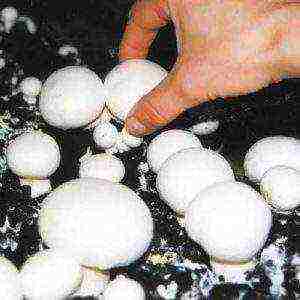 On their hundred square meters, summer residents cultivate almost everything. But if you ask whether mushrooms are grown at home, then few people will answer in the affirmative. And, nevertheless, their breeding is not only possible, but also advisable. They are both an excellent addition in the form of various dishes to the everyday table, and a very profitable business. This primarily applies to champignons, given their market value. Although their excellent taste is somewhat leveled by the "biting" price, they are in demand, and considerable. The basis of success is knowledge of the intricacies of the technology of growing these mushrooms and a competent approach to business.
On their hundred square meters, summer residents cultivate almost everything. But if you ask whether mushrooms are grown at home, then few people will answer in the affirmative. And, nevertheless, their breeding is not only possible, but also advisable. They are both an excellent addition in the form of various dishes to the everyday table, and a very profitable business. This primarily applies to champignons, given their market value. Although their excellent taste is somewhat leveled by the "biting" price, they are in demand, and considerable. The basis of success is knowledge of the intricacies of the technology of growing these mushrooms and a competent approach to business.
There are several methods for growing mushrooms at home. The only difference is in some details. For example, in the way of implementation, the volume of production. Everyone is free to decide for himself what exactly he needs - cultivation of champignons for their own consumption or for sale. Knowing the ultimate goal and focusing on your capabilities, choosing the best methodology, making the necessary adjustments to certain types of work will not be difficult. The main thing is to understand all the nuances of the technological process.
Growing methods
It is more correct to start from this point, so that the reader immediately understands, firstly, that there is nothing particularly complicated in this, and secondly, whether he will be able to implement any of the listed technologies, taking into account his own capabilities and needs.
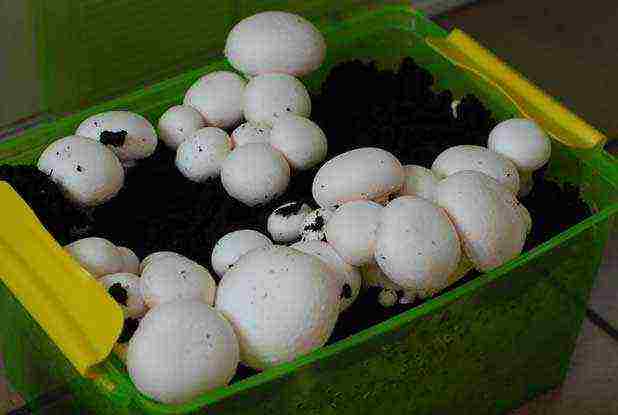
Favorable conditions for mushrooms
They don't need much:
- Humidity (%) - above average (about 70 - 80).
- Temperature (ºС) - moderate, within 18 ± 4.
- Good air exchange. And how to organize ventilation - natural or forced, is decided on the spot.
And virtually no maintenance, unlike most horticultural or ornamental crops.
In the garden
In this case, it means not only a plot on the site, but also a certain area in a greenhouse, a voluminous basement, an empty barn, a vegetable store, and so on. All that is needed is some segment of the territory (horizontal base), on which the prepared soil mixture can be poured.

Step-by-step instruction:
- Base waterproofing. Since champignons need high humidity, it is necessary to exclude the "leaving" of water in the ground. The simplest way is to trim it and cover the entire area of the future bed with polyethylene film (preferably thick; it is stronger).
- Laying the substrate. The recommended layer thickness is 35 ± 5 cm.
- Sowing mycelium. You can choose between two common techniques.The first is that grooves are made in the soil, into which the planting material is loaded, which is the thinnest bodies - "mushroom" champignon threads (vultures).
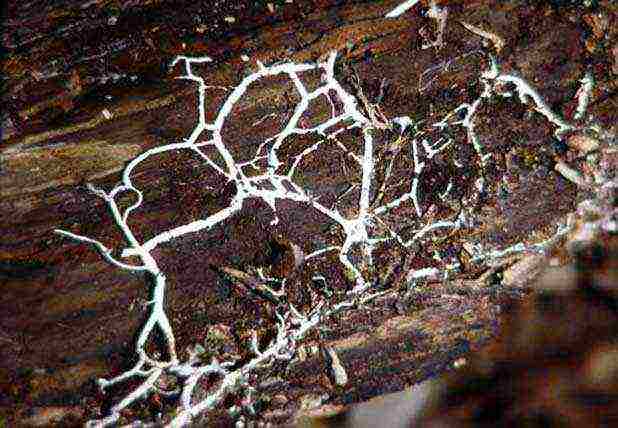
That is, in the same way as the seeds of carrots, beets and a number of other crops are sown. The second technology is not more complicated. The planting material is simply scattered over the surface. So that the mycelium is well fixed in the substrate, there is again a small (about 5 cm) layer of cooked earth on top.
It remains only to organize the systematic irrigation of the beds. For the growth of mycelium, the soil must be kept moist all the time. Plus - to regulate the temperature (when it comes to the room) at the required level. The first mushrooms can be expected to appear in about a couple of months.
Advantages:
- The simplicity of this technology.
- Virtually no preparatory activities other than choosing a location.
- Minimum investment. Only for the purchase of mycelium. The cost of 1 sachet is within 150 rubles.
Minuses:
- There is a high risk of mushroom infections. It is clear that it is impossible to clean up ready-made beds with planted mycelium. Therefore, when visiting a room with mushroom mycelium, you will have to follow the rules of hygiene. Change of shoes and so on. If the bed is on the site, in a shaded place, it is much more difficult to fulfill all the sanitation requirements.
- The impossibility of changing the position of the mycelium. How significant this disadvantage is, it is up to the owner of the territory to decide. But it's still worth noting.
- Difficulty in mushroom harvesting.
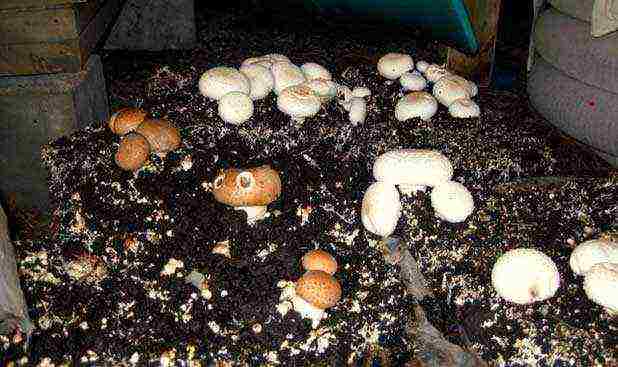
On racks
This method is known as Dutch technology.
The difference from the horizontal method is that the substrate is loaded into containers (preferably plastic containers). They can be put on shelves (or they can be turned into separate compartments), knocked together pallets, and so on - there are enough options.
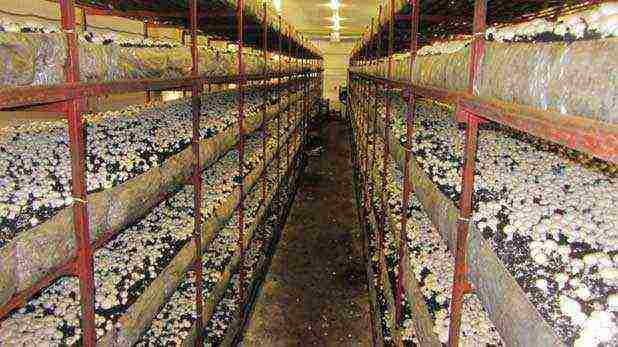
You can do so - to make a kind of shelves with drawer shelves. It is much more convenient.
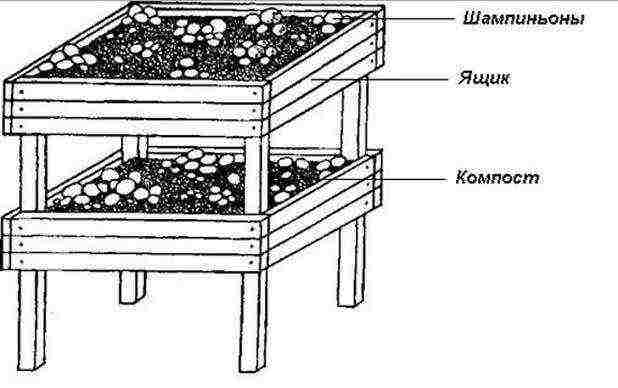
Advantages:
- Rationality of placement, regardless of the chosen location. Moreover, if necessary, it is easy to change it.
- Significant space savings. Shelves can be arranged in floors, tiers.
- High quality care. First of all, the fight against infections is greatly facilitated.
- A sharp decrease in labor costs, taking into account the mechanization of the process.
Minuses:
- Some of the complexity of caring for mushrooms is due to the fact that in the process you will have to look after each container (compartment) separately. Do a soil revision, determine lesions and the like.
- Experts note the high cost of this technology. Even very rough estimates show that growing mushrooms on an area of 100 m² requires financial investments of at least 500,000 rubles. For example, for the organization of drip irrigation and much more. But this is for the volumetric production of champignons.
When you receive them in relatively small quantities (for yourself), large costs will not be required (substrate + containers). Perhaps artificial heating. Therefore, this "minus" is somewhat leveled.
In bags
Naturally, in polyethylene.
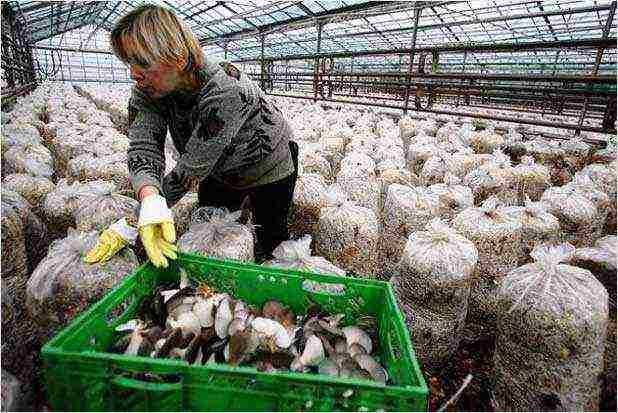
Step-by-step description of the process:
- The substrate is loaded into the bags, up to the top, and compacted a little.
- Water is poured. So that the soil becomes wet throughout its depth.
- Small holes (8-10 cm in diameter) are made in the walls of the bags. Usually a checkerboard pattern is chosen. This allows you to grow mushrooms more compactly.
- The mycelium is placed in the formed "nests" of the improvised grid.
Advantages:
- For home - the most rational way. The bags can be positioned wherever and however you like, moved to another place if required.
- All costs are reduced only to the purchase of containers and mycelium.
- In fact, the entire mycelium is divided into parts, completely isolated from each other. If it is damaged in one of the bags, it is disinfected or thrown away.But the "infection" with this method will never spread throughout the room.
The only drawback is the increased labor costs. First of all, this is due to loading the substrate into bags and sowing mycelium in the holes.
In containers
This is the most homely way, since this technology is easy to organize in the apartment. Containers with the substrate can be placed anywhere - on the balcony, windowsill, under the closet (closer to the heating radiator), not to mention extensions to private houses, basements, and so on.
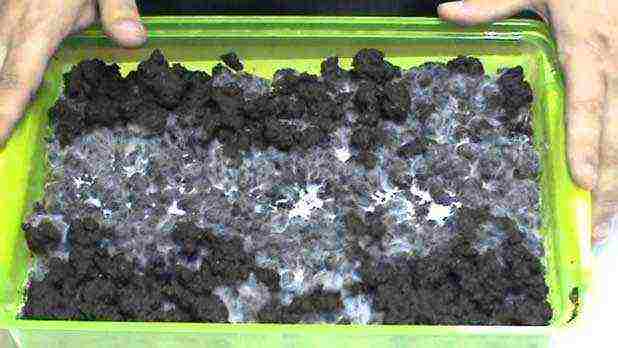
Step-by-step description of the process:
- Preparation of containers. You need not only the "dishes" itself, but also a lid with a tray.
- Disinfection of containers.
- Loading the substrate.
- Sowing mycelium. The approximate depth is 4.5 cm.
- Moisturizing the soil with mycelium.
The practice of cultivating champignons in this way shows that watering should be the main focus. Temperature is a secondary factor. But if it is higher than the recommended value (for example, about 26 - 27 ºС), then the development of fungi occurs more intensively.
This technology has many advantages, but there are practically no disadvantages. For your own consumption (considering that no one will eat mushrooms every day), it is enough to "charge" 3 - 4 small containers. It will take a little time for this, care is minimal (only watering), and where to place them is easy to guess.
There are a number of other ways, but it makes no sense to consider them. They are hardly suitable for the home. For example, block breeding of champignons. A similar container is made in production, mainly from organic matter (manure, seed husks, peat, sawdust), pressing the prepared mixture. There are advantages, but, according to the reviews of those who grow mushrooms at home, everything "crosses out" a significant disadvantage - such containers are short-lived (enough for a maximum of 3 crops), they quickly collapse (you will have to look for a strong "shell"), and with their transportation big problems. All this together leads to significant costs.
Substrate preparation
For those who realized that it is worth it to breed mushrooms at home, the question of preparing the soil mixture is no less interesting. The substrate (in some sources it is called compost) is a nutrient medium for planting the mycelium, from which the mycelium develops. Instructions for its preparation are placed on the back of the package with planting material or attached on a separate piece of paper. Therefore, there are no problems with this.

The main components of the substrate:
- Rotten manure (horse).
- Hay or straw (fresh).
- Various additives - chalk, bone meal, superphosphate and a number of others.
In principle, following the manufacturer's instructions, it is not difficult to prepare a nutrient medium for mushrooms, knowing the fractional ratio of the components. Especially when it comes to a relatively small amount of substrate.
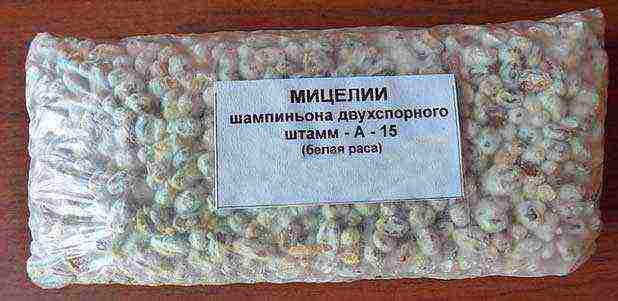
The article provides complete information on growing mushrooms. Well, it is not difficult to decide which of the ways to choose, taking into account your capabilities and the required volumes of mushroom production.
Landing on a regular horizontal ridge
As expected, let's start with the cheapest, simplest method that will satisfy the needs of many farmers. An ordinary garden bed is a layer of soil with fertilizers, which is located in a basement, a greenhouse. An old vegetable store, a shallow mine, an indoor poultry house, and the like is ideal for growing. The main thing is that there is high humidity in the room, and the temperature is a secondary indicator, it can be adjusted using heaters. Consider the step-by-step instructions for growing mushrooms on the ridge.
> Step 1:Laying compost.
First, the floor is leveled, then a plastic wrap is laid on it, which will retain moisture. Compost up to 30-40 centimeters thick is applied to it.
> Step 2:Sowing with mycelium.
The purchased seed can be sown immediately into the furrows previously made in the compost, it can be scattered on top, and then covered with another layer of compost of 4-5 centimeters.
> Step 3:Watering and maintaining the temperature.
It is necessary to fill the crops abundantly so that they are constantly saturated with moisture, only then the mycelium will grow well, and new fruiting bodies will appear within 10-12 weeks after sowing.
Today, more than 80% of all farmers use this method, since it is really profitable. There are many advantages of this method, let's take a closer look at them.
- There is no need to purchase expensive trays, so you can save 600-700 rubles for one.
- Quick bed equipment. It can be done in almost 1 day, you just need to pour the ready-made compost. With trays, bags, there is much more red tape.
- Rational use of the usable area.
There are, of course, more disadvantages. First of all, we pay attention to infections. If they occur, they spread throughout the garden, and this can be a very serious loss. You also need to take into account that it is impossible to clean the room, therefore, sooner or later, infections brought by shoes from the street or simply on a person's clothes will start... Another disadvantage is the inability to raise the bed to a comfortable height, so manual labor will be much more difficult than with Dutch technology.
Growing mushrooms at home on shelves
This is a more modern way, which provides for convenient placement in drawers. This is the so-called Dutch growing method, which provides for the rational use of indoor space, as well as the highest quality care. The shelf system provides for the use of special mechanized equipment, therefore it is considered more expensive. Many farmers abandoned this method precisely because of its relative high cost. The minimum start-up capital for a 50 square meter facility is $ 8,000.
The profitability of production starts from only 6 kg / 1 m2, so it will be profitable to grow only good hybrids that will produce a lot and often. But, with good yields, the method is very practical, since labor costs are reduced by 2-3 times compared to horizontal ridges. As a container for the substrate, plastic forms are used, from which rows are made, they go one above the other. Drip irrigation is necessary, since with conventional sprayers, infections that enter the upper row will quickly spread to the lower containers.
How to grow champignons in a basement in regular bags
This is the most popular method for oyster mushrooms, but in recent years, mushrooms have also begun to gradually move to polyethylene, as this is one of the most practical methods to get a good harvest with little labor and low material investment. Let's take a closer look at how to make the mushroom grow out of the bag.
> Step 1:We prepare the substrate.
To do this, we need 15 kg of horse manure, 3 kg of straw, 2 kg of sunflower husk, 5-6 kg of black soil, 2 kg of mullein. We mix all of the above ingredients and get an excellent mixture for planting mycelium.
> Step 2:We are waiting for it to burn out.
Fill with plenty of water and wait for a temperature of +80 degrees. After 20 days, spread the soil mixture with a thin layer, dry it.
> Step 3:We throw everything into a bag.
Everything is simple here. We fill the bag to the top, make it very dense, pour water into it so that the moisture content of our mixture is as high as possible.
> Step 4:We sow the mycelium, put the bags.
Holes are made in the bag, about 10 centimeters in diameter, in a checkerboard pattern so that the bag does not burst. You get a polyethylene surface in a mesh, where you will need to place mycelium in each cell.
The technology allows you to save on the purchase of containers, but, at the same time, gives all the advantages of shelf cultivation. If an infection gets into one bag, you simply throw it away or disinfect it, bacteria do not spread to neighboring blocks. Of the shortcomings, the most significant is manual labor at the first stage, which will take a lot when filling each bag, stirring, moistening, planting mycelium.
Container way
Americans are the most knowledgeable about how to grow mushrooms at home. It was they who came up with the aerated (ventilated) growing containers. This method allows you to get fresh fruit bodies even on the balcony in the apartment, not to mention the basements. To do this, you need a special container with a lid and a pallet, into which all the moisture will drain. The compost is prepared as for growing in bags, after which it is placed in wooden containers, previously disinfected at a temperature of +200 degrees in an oven.
Then the mycelium is sown to a depth of 4-5 centimeters, the soil is moistened, placed in a warm place (a temperature of up to +28 degrees is needed). The method is very effective and convenient, especially when an infection enters the soil. You can easily localize the epidemic, since it will not go further than one container. The biggest disadvantage of this method is the high cost for an industrial scale, so farmers very rarely use it in Russia. If you have not yet figured out how to grow mushrooms at home without unnecessary "dust and noise", then this one will suit you. Compact containers fit in any basement or room.
How to grow champignon mushrooms in blocks and what is it
Blocks (or as they are also called - briquettes) are presses specially prepared for production from manure, husk of seeds, sawdust, peat. The ideal ratio of all components, as well as high-quality mixing on the production equipment, will benefit the future harvest.
The advantages of this growing method are many. You do not waste time, effort, money on the construction of beds, you get ready-made material. Typically, compost is sold in cylindrical or rectangular polyethylene blocks. You can hang it on a rope, or just put it in a prepared metal container. It is very easy to change it, so growing mushrooms at home does not require much effort: we collect 3-4 waves of mushrooms and discard the "filling" of the metal box. We buy a new briquette, put it in, add mycelium. The main disadvantage of this method is the same as in the previous one - the cost. However, since the first 3 waves give about 80% of the crop, such a frequent change of the substrate will be to some extent even beneficial if you want to get stable and large champignon yields.
